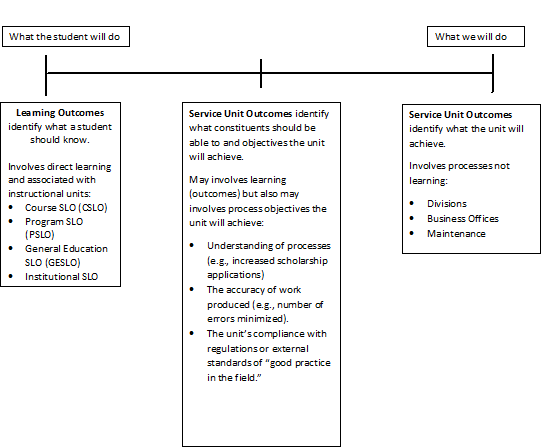SUO's
Service Unit Outcomes (SUOs)
Student Unit Outcomes (SUOs) are measurable statements that describe significant knowledge or skills students should learn or be able to demonstrate after receiving a service, support resources or participating in a Student Services support Unit/Dept./program.
SUOs can be educational and/or process based. These statements may identify what its constituency group (primarily students) should know/do because of an activity or what a unit would like to accomplish for its constituency group. Non-instructional units/areas develop SUOs (Service Unit Outcomes).
Student Services/Units Outcomes Assessment
Student Support Services programs are an important factor in the student experience. Student Services promotes learning through support resources such as educational planning, academic advising, counseling, admissions, and other administrative services that lead to student success. Assessment of services is vital in demonstrating the effectiveness and value of student support services and programs. SUOs are assess every year and remain the same throughout a four-year program review cycle.
Each Service Unit should have outcomes defined that focus on:
- Services being provided equitably and efficiently
- Support being provided by the program/unit in a satisfactory manner
Each Service Unit Outcome should assess:
- What skills or knowledge the unit expects students who participate in the program to come away with (Vision for Success)
- What essential processes or functions (services) should students learn that could help them with their academic success
- How student support services and programs relate to the institutional goals (Achievement Data)
Difference between Goals and SUOs
A program goal is a high-level statement that defines the purpose and desired outcomes of a program. It represents the overarching aim of the program and sets the direction for the program activities.
A service unit outcome, on the other hand, is a specific, measurable result that is expected to be achieved through the delivery of a specific service within the department/program. Service Unit Outcomes are more concrete and tactical, and they provide specific indicators of success for the department/program. In other words, a goal is a broad statement of the desired impact of a unit, while a Service Unit Outcome is a specific, measurable result that contributes to achieving the department/program goal.
Goal example:
Admissions and Records will streamline the admissions process and improve the student experience.
Service Unit Outcome example:
Reduce the average processing time for student applications from 30 days to 15 days within the next academic year.
Goal example:
To increase the enrollment and retention rates of first-year students in the RTG Program.
Service Unit Outcome example:
Increase the number of first-year students who enroll in and complete their first semester by 10% within the next academic year.
Goal example:
Psych services: To improve mental health and well-being among college students.
Service Unit Outcome example:
Increase the number of students seeking counseling/psych services by 20% within the next academic year.
Goal example:
To provide career guidance and support to students who attend Counseling career workshops.
Service Unit Outcome example:
Increase the number of students who secure job offers within 6 months of graduation by 10%.
Difference between SLOs and SUOs
Student Learning Outcomes (SLOs) are specific, measurable statements that describe what students should know or be able to do as a result of completing a course or program. They are used to assess the effectiveness of instruction and guide curriculum development. Service Unit Outcomes (SUOs) are similar in that they are specific and measurable statements, but they describe what a service unit (such as a department or office) should accomplish in order to support the mission and goals of the larger institution. They are used to assess the effectiveness of the service unit and guide its planning and development. In summary, SLOs focus on the student's learning and SUOs focus on the unit's performance.
STUDENT LEARNING OUTCOMES AND SERVICE UNIT OUTCOMES

Developing Service Unit Outcomes
SUOs can be instructional and/or process based. These statements may identify what its constituency group (primarily students) should know/do as a result of an activity or what a unit would like to accomplish for its constituency group.
Helpful Documents:
SUO Assessment at FCC (See Link)
Developing SUOs (See Link)
Planning Assessment
Based individual units, employees will determine when to assess the service unit outcomes. The information can be documented in on the form below.
Helpful Forms:
SUO Assessment Calendar (see link)
Assessing Service Unit Outcomes
Depending on the type of SUO employees within each area will determine whether to use direct or indirect assessment methods. Direct assessment methods might include portfolios while indirect assessment methods may include surveys or focus groups.
Documentation of Results and Follow-Up
Once employees administer the assessment and collect results, they meet to discuss the results. These discussions typically occur the semester following the assessment study; the dialogue and planned follow-up is captured on the form below.
Helpful Forms:
SUO Assessment Report (see Link)
FRESNO CITY COLLEGE IDENTIFICATION OF OUTCOMES
|
INSTRUCTIONAL - “Courses” |
NON-INSTRUCTIONAL – “Services” |
|
What students will learn! |
What FCC will do! |
|
Student learning outcomes (SLOs) are instructional and include statements that identify what students should be able to do or know as a result of leaving a specific course. If you have a COR you identify SLOs for your Program. Student Learning Outcomes (SLOs) are specific, measurable statements that describe what students should know or be able to do as a result of completing a course or program. They are used to assess the effectiveness of instruction and guide curriculum development.
|
Service unit outcomes (SUOs) can be process or satisfaction based. These may identify what its constituency group (students, employees, general public, etc.) should know/do as a result of an activity or what a unit would like to accomplish for its constituency group. If you do not have a course outline of record you identify SUOs for your unit. In other words (SUO’s) are specific and measurable statements, but they describe what a service unit (such as a department or office) should accomplish to support the mission and goals of the larger institution. They are used to assess the effectiveness of the service unit and guide its planning and development. In summary, SLOs focus on the student's learning and SUOs focus on the unit's performance. |
|
Student Learning Outcomes (SLOs) · Relate to instruction. · Identify what a student should know. · Identify what a student should be able to do. · Involves direct learning. |
Service Unit Outcomes (SUOs) · Identify what constituents should be able to do as a result of the service. · Identify what the service unit should be able to do. · Identify process outcomes the service unit will achieve. |
|
Student Learning Outcomes Include · Course SLO (CSLO) · Program SLO (PSLO) · General Education SLO (GESLO) · Institutional SLO (ISLO)
|
Service Unit Outcome Examples · Understanding of processes (e.g., increased scholarship applications) · The accuracy of work (e.g., number of errors reduced). · The completion rates of students (e.g. meets or exceeds target rate) · The unit’s compliance with regulations or external standards of “good practice in the field.” |
Goals, Outcomes, and Activities for any program flow from the mission of the college.
Fresno City College’s Mission: “Fresno City College, California’s first community college, provides quality, innovative educational programs and support services directed toward the enhancement of student success, lifelong learning and the economic, social, and cultural development of our students and region.”
|
Non-Instructional/Service Units |
|
|
Goals identify what the unit intends to accomplish and are NOT measurable. |
(IR) Facilitate a culture of inquiry at FCC. |
|
Outcome statements are the measurable statements that indicate what a constituent group should know, be able to do, or be satisfied with as a result of encountering a unit. |
(IR) Constituency groups will report satisfaction regarding the use of data dashboards for program review. |
|
Activity statements identify what the unit will do to help constituency groups meet outcomes |
(IR) Train groups on the use and purpose of data dashboards. |






